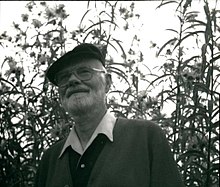American botanist and ethnobotanist
Charles Bixler Heiser Jr. (1920–2010) was a professor of botany, known as a leading expert on the sunflower genus Helianthus.[2][3][4] He is also noteworthy as the author of a "series of popular books that did much to promote botany to the general public."[2]
Biography
After graduating from Belleville Township High School, Illinois, where he was the senior class president, Heiser attended Washington University in St. Louis. There he was mentored by Robert Everard Woodson and Edgar Anderson and graduated with A.B. in 1943 and M.A. in 1944.[2] In 1944 and the first part of 1945, Heiser was an instructor in the botany department at Washington University in St. Louis.[5] In 1945 he began study for his Ph.D. at the University of California, Berkeley, where he worked with G. Ledyard Stebbins on the genetics of sunflowers, although Louis Mason was Heiser's official doctoral advisor.[2] In 1947 Heiser received his Ph.D. and an edited version of his doctoral dissertation was published in the journal Evolution.[6] For the academic year 1947–1948 he had a teaching position at the University of California, Davis. At Indiana University he was from 1947 to 1951 an assistant professor, from 1951 to 1957 an associate professor, from 1957 to 1979 a (full) professor, and from 1979 to 1986 a distinguished professor, retiring in 1986 as distinguished professor emeritus.[2] He supervised 29 doctoral students and remained scientifically active in retirement, including at the Indiana University/Deam Herbarium.[4]
In 1953, as a Guggenheim Fellow, he went on sabbatical leave in Costa Rica to study chili peppers and learn about the local flora. At the Instituto Interamericano de Cooperación para la Agricultura in Turrialba, Costa Rica, he met two students from Ecuador: Jorge Soria and Jaime Díaz. They were important in helping him on his two sabbatical years, 1962 and 1969, in Ecuador.[2]
Heiser, working with Soria,[7] developed a nematode-resistant hybrid between naranjilla cultivated in Ecuador and cocona cultivated in Amazonia. The hybrid became commercially significant and widely cultivated in Ecuador.[2]
In 1944 Heiser married Dorothy Gaebler (1921–2015), who was a graduate student in the botany department of Washington University in St. Louis. Upon his death in 2010 he was survived by his widow, two daughters, a son, and seven grandchildren.[4] In 1969 on a flight to Ecuador, Heiser, his wife, and two children were hijacked to Cuba.[2][8]
Controversy over the origin of the domesticated sunflower
Heiser and several other ethnobotanists claimed that the domesticated sunflower originated in pre-Columbian North America and not in pre-Columbian Mexico.[9][10][11][12] However, other experts have disputed the claim.[13]
